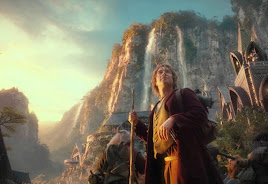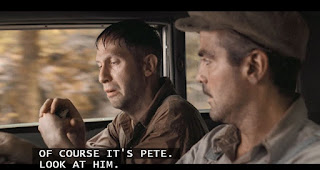I HATE the saying "the right side of history." LOATHE it. It takes human mean-spiritedness to a whole new level of self-centered vacuity.
Supposing that some events and values and outcomes are better than others--and I think that the position has validity--what's the problem with "the right side of history"?
1. Babies and bathwater Good events and values and outcomes rarely come un-entwined with other stuff.
There's a great Black Adder episode in which an election takes place. It is the Regency Era and one of the candidates wants "the ending of slavery and the compulsory eating of asparagus."
The reporter says, "I understand your point about asparagus but what's up with your stance on slavery?"
The (entirely historically accurate) point being made is that many people (Abolitionists, Millennialists, and Reformers) in the same era had what we moderns would deem rational and valid ethical points about the treatment of others. Unfortunately, they tended to combine those rational and ethical points with ideas that strike many modern folks as...nuts--such as the compulsory eating of asparagus.
Likewise, certain advancements that strike people as utterly rational will get paired with ideas that MIGHT seem valid at the time but in the end turn out very much not to be--such as the pairing of birth control with eugenics in the early twentieth century.
2. Chronocentrism How much is the "right side" based on perception?
I mention elsewhere that Ancient Athenians in 590 B.C.E. could be excused for believing that democracy as an experiment had entirely failed; Jews and Christians in 70 C.E. could be excused for believing that their belief systems would remain small and constantly under literal fire. And for those people in that time, that was the reality.
But democracy is now with us as is Judaism and Christianity.
Wouldn't Ramsesses II from 1200 BCE be surprised?!
As for Henry VIII...actually, I don't think Henry VIII would be surprised to see his line replaced: he was that paranoid.
But Shelley's poem is entirely appropriate. What people thought would die didn't. What people thought would thrive didn't.
3. More chronocentrismSaying, "The winners write history" depends ENTIRELY on when one stops and looks back.
In my posts on the Protestant Reformation, I point out that at different points along the line from Henry VIII to William of Orange (who was more interesting than I realized), any particular group could be excused for thinking, "That's it! My side is over and done with!" or "That's it! My side won! Ha ha ha!"
For that matter, the Calvinists or Congregationalist in late eighteenth-century America could be excused for blithely assuming (as they did) that Congregationalism would always be the most influential Christian sect coming out of New England.
Between 1750 to 1850, they were almost entirely replaced by Baptists and Methodists with the Catholics remaining steady.
As the late great PJ O'Rourke points out, attitude also contributes to that "when"--see quote and #4.
4. Arrogance
Are you right? Really?
Really?
The supporters of eugenics believed that they were absolutely on the advanced "here is what the future will look like" side of history. And the philosophy/cause spread across political parties. Political libertarians and Catholics were treated like America's nutty, delusional, cat-mad aunts for standing out against what appeared so good and righteous and inevitable.
Going back further, the Salem Witch Trials were criticized by one Mather and supported--at
least the legal aspect--by another.
My posts about the Protestant Reformation involve a queen who was threatened for not going far enough, a queen who thought she was restoring the true religion to the country, a bunch of fanatics who felt entirely justified in killing a king and so on and so forth.
I am not arguing against taking a position on a topic. Waffling also has its problems. As Mike Baxter points out, "naming public institutions after the most boring people we know" may have its advantages, but even that could backfire. The "safe" name or position now may not be "safe" tomorrow.
A position that can't see the flaws, the problems, the possible arguments against itself...
...is not the "right side of history."
It's just a side with blinders on.
5. Imperfection makes an event memorable--not merely someone being lucky.Like many causes/events that run out
of control, the Salem Witch Trials at their height were almost impossible to criticize. People who dared could end up in jail and then hung.
And yet people did criticize it.
And many of those critics--Puritan ministers from all over New England--believed in things we moderns would deem wrong and bizarre. But they also raised points about what constitutes evidence that we would comprehend and even support. The second trial never went forward due to a combination of political events, scandal (the young women were accusing more and more people unknown to themselves), and growing criticism.
Within a decade of the trials, people who had taken part made public formal apologies.
Is the event memorable because it was so awful? Or
memorable because people at the time actually regretted it? The event stands out in colonial memory as being an aberration rather than what it likely would have been a few decades earlier, just another day in court.
As I comment in my posts on utopias...when we are in the moment, the time, the years, yes, we behave like Victorians as encapsulated in Dickens' opening to Tale of Two Cities: "It was the best of times; it was the worst of times..." We think the entire universe circles around us and our emotions and our experiences.
 |
Professor Aldrete
|
Whatever we may imagine or wish or dread, life keeps moving forward. In a few years, what seems of great importance fades or, possibly, becomes terribly important yet...people still move on to something else. The biggest fault with social media is the fundamental lie that we are the center of other people's worlds. (I suggest that most mental issues surrounding social media come down to the belief that what people write and what people read has more meaning and purpose than it ever will in reality.)
Truth: most people--most ordinary people within history--have done the best they could at the time the best way they could based on what they could best discern by using their brains. They aren't the center of anything. Their deeds, in the long run, mean a great deal to the people around them but little to history books.
In other words, non-wealthy, non-writing, non-powerful, non-remembered people, which is nearly everybody, those people who had families and farms and jobs, who went to festivals and underwent ceremonial rites, who taught things to others and discussed stuff and told stories...those people were muddling along, just like the people before them. Like us. They deserve respect rather than theoretical labels, name-calling, and "wrong side" disdain.
"The right side of history" isn't just stupid.
It lacks compassion.




.JPG)



















.JPG)


























